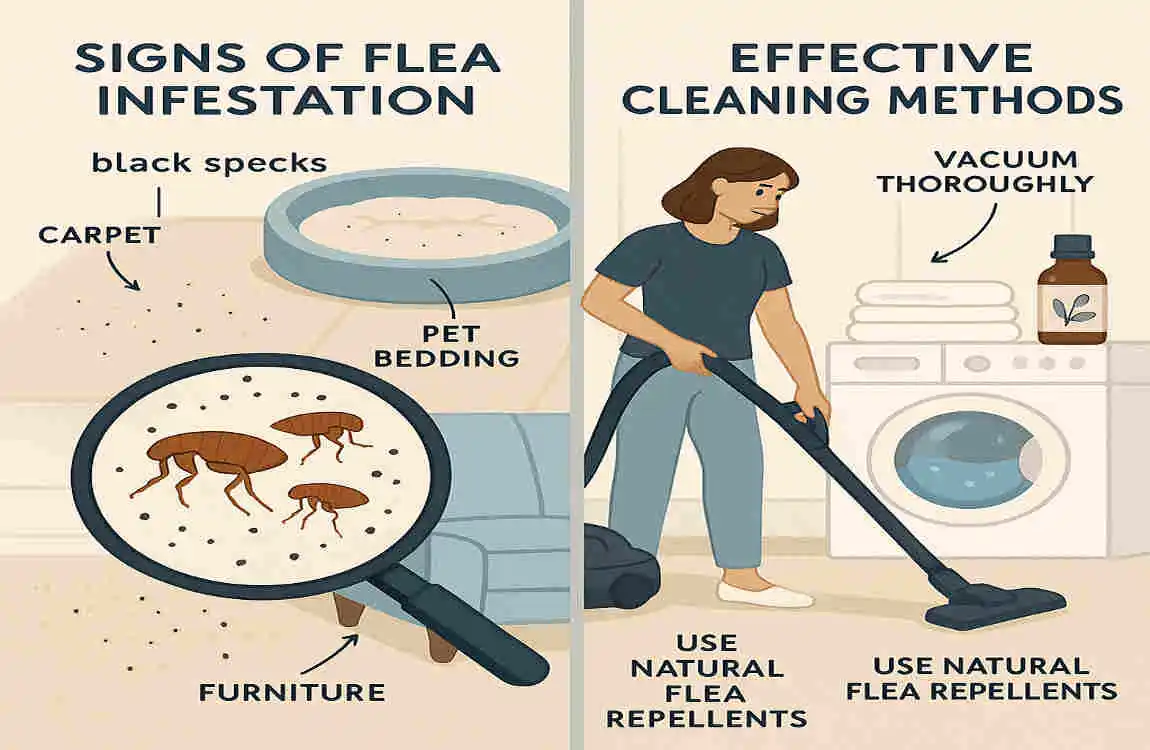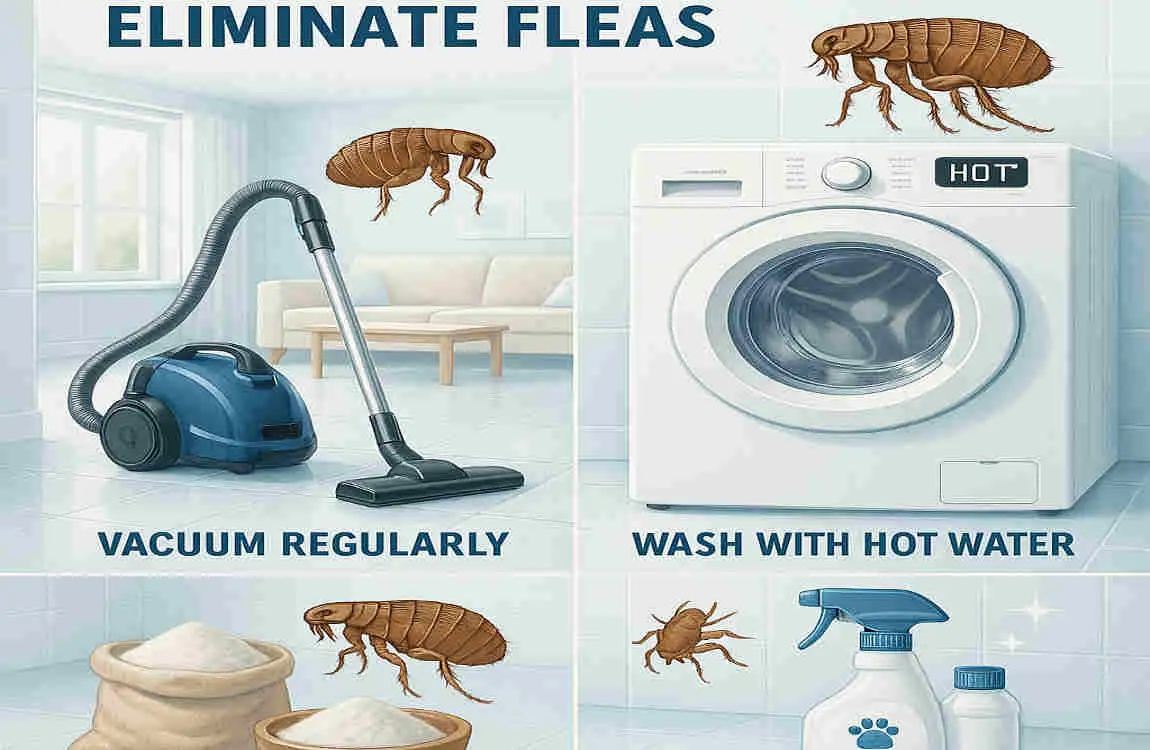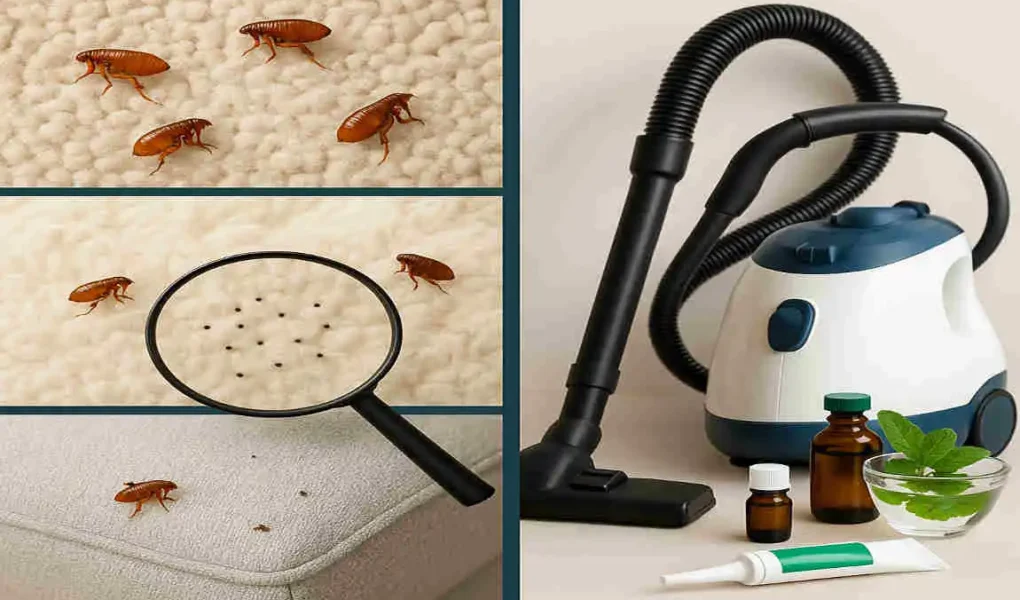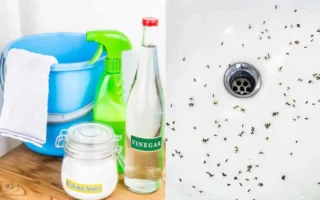Even if you keep your home spotless, fleas can still find their way in and become a significant nuisance. These tiny pests can cause discomfort for both you and your pets, and early detection is key to preventing a full-blown infestation.
Understanding Fleas: Basics and Behavior

What Are Fleas and Why Do They Infest Homes?
Fleas are small, wingless insects that survive by feeding on the blood of mammals and birds. They are notorious for infesting homes because they can easily hitch a ride on pets, people, or even inanimate objects. Once inside, they can quickly multiply and spread throughout your living space.
Common Sources of Fleas
Fleas can enter your home through various means, including:
- Pets: If your furry friend comes into contact with an infested animal or environment, they can bring fleas back to your home.
- Visitors: Guests may unknowingly carry fleas on their clothing or belongings.
- Open windows: Fleas can jump through open windows, especially if your home is near an infested area.
Fleas in a Clean Home
You may wonder how fleas can thrive in a clean home. The truth is, fleas don’t care about the cleanliness of your living space. They are more interested in finding a host to feed on and a suitable environment to lay their eggs. Even if you vacuum regularly and keep your home tidy, fleas can still find hiding spots in carpets, furniture, and pet bedding.
Flea Lifecycle and Its Impact on Detection and Treatment
Understanding the flea lifecycle is crucial for effective detection and treatment. Fleas go through four stages: egg, larva, pupa, and adult. The entire process can take anywhere from a few weeks to several months, depending on environmental conditions. This means that even if you eliminate the adult fleas, eggs and larvae may still be present in your home, ready to hatch and restart the cycle.
Signs You Have Fleas in Your Clean Home
Physical Signs on Pets and Humans
One of the most apparent signs of a flea infestation is the presence of bites, itching, and irritation on your pets and family members. Flea bites often appear as small, red, and itchy bumps, usually on the legs, ankles, and lower body. If you or your pets are experiencing these symptoms, it’s time to investigate further.
Visual Signs of Fleas in Your Home
In addition to physical signs on your body, you may also notice visual evidence of fleas in your home. Look for:
- Flea dirt: These are small, black specks that resemble pepper and are actually flea feces.
- Live fleas: You may spot these tiny, dark insects jumping around on your pets, carpets, or furniture.
Flea Comb Test on Pets
To confirm the presence of fleas on your pets, you can perform a simple flea comb test. Here’s how:
- Start by combing your pet’s fur with a fine-toothed flea comb.
- Pay close attention to areas where fleas tend to congregate, such as the neck, tail, and underbelly.
- After a few strokes, examine the comb for any signs of fleas or flea dirt.
If you find fleas or flea dirt on the comb, it’s a clear indication that your pet has fleas, and your home may also be infested.
Unusual Behaviors in Pets or Family Members
Another sign of a flea infestation is unusual behavior in your pets or family members. If your pet is constantly scratching, biting, or licking themselves, it could be a sign of flea discomfort. Similarly, if you or your family members are experiencing excessive itching or restlessness, fleas may be the culprit.
Light and Water Test for Flea Detection in Carpets
To detect fleas in your carpets, you can perform a simple light and water test. Here’s how:
- Fill a shallow dish with soapy water and place it on the floor near a suspected flea hotspot.
- Position a lamp or flashlight above the dish, shining the light onto the water.
- Leave the setup overnight and check the dish in the morning.
If you find fleas trapped in the soapy water, it confirms that your carpets are infested with these pesky insects.
How to Know If You Have Fleas in Your Clean Home: Key Detection Techniques
Inspecting Common Flea Hotspots
To effectively detect fleas in your clean home, focus on the areas where they are most likely to congregate. These hotspots include:
- Bedrooms: Fleas are attracted to warmth and carbon dioxide, making bedrooms a prime target for infestation.
- Pet areas: If you have pets, their sleeping and resting areas are likely to be infested with fleas.
- Carpets: Fleas love to hide in the fibers of carpets, where they can easily access their hosts.
When inspecting these areas, look for signs of flea activity, such as flea dirt, live fleas, or unusual behavior in your pet.
Tools and Products for Flea Detection
Several tools and products can help you detect fleas in your home, including:
- Flea combs: These fine-toothed combs are designed to trap fleas and flea dirt in your pet’s fur.
- Flashlights: A strong flashlight can help you spot fleas and flea dirt in dark corners and crevices.
- White socks: Wearing white socks and walking around your home can help you detect fleas, as they are attracted to the movement and color.
Importance of Regular Inspections
Even if your home is clean, regular inspections are essential for detecting fleas early. By checking for signs of fleas every week, you can catch an infestation before it gets out of hand. Make it a habit to inspect your pets, carpets, and furniture regularly, especially during flea season.
Differentiating Fleas from Other Pests or Skin Irritations
It’s essential to differentiate fleas from other pests or skin irritations to ensure proper treatment. Here are some key differences:
- Flea bites: Flea bites are typically small, red, and itchy, often appearing in clusters on the lower body.
- Bed bug bites: Bed bug bites are larger and more swollen than flea bites, often appearing in a straight line on exposed skin.
- Skin irritations: Skin irritations caused by allergies or other factors may resemble flea bites but are usually more widespread and less concentrated.
If you’re unsure whether you’re dealing with fleas or another issue, consult a veterinarian or pest control professional for guidance.
Professional Flea Detection Services
In some cases, you may need to enlist the help of a professional flea detection service. These experts have the knowledge, tools, and experience to thoroughly inspect your home for signs of fleas and provide you with a comprehensive report. Consider hiring a professional if:
- You’ve tried DIY detection methods without success.
- You have a severe flea infestation that requires immediate attention.
- You want to ensure your home is completely flea-free before bringing in new pets or furniture.
Cleaning Tips to Eliminate Fleas Effectively

Preparing Your Home for Flea Cleaning
Before you start cleaning, it’s essential to prepare your home for the task at hand. Here’s what you should do:
- Remove clutter: Clear out any unnecessary items from your floors and surfaces to make cleaning easier and more effective.
- Wash pet bedding: Launder your pet’s bedding, toys, and accessories in hot water to kill any fleas or eggs.
- Vacuum thoroughly: Vacuum your entire home, paying special attention to areas that attract fleas, such as carpets, furniture, and pet areas.
Deep Cleaning Carpets and Rugs
Carpets and rugs are prime hiding spots for fleas, so it’s essential to give them a deep clean. Here’s how:
- Use a steam cleaner: Rent or purchase a steam cleaner and use it on your carpets and rugs, following the manufacturer’s instructions.
- Apply a flea-killing powder: Sprinkle a flea-killing powder, such as diatomaceous earth, onto your carpets and rugs before vacuuming.
- Vacuum multiple times: Vacuum your carpets and rugs at least twice, using slow, deliberate strokes to ensure you capture as many fleas and eggs as possible.
Washing Pet Bedding and Fabrics
In addition to deep cleaning your carpets and rugs, you should also wash your pet’s bedding and any fabrics that may be infested with fleas. Here’s what to do:
- Use hot water: Wash your pet’s bedding, toys, and accessories in the hottest water possible to kill fleas and eggs.
- Dry on high heat: Dry the items on the highest heat setting to ensure any remaining fleas or eggs are eliminated.
- Repeat as needed: If your pet continues to show signs of fleas, repeat the washing process until the infestation is under control.
Vacuuming Strategies
Vacuuming is one of the most effective ways to eliminate fleas from your home. Here are some strategies to keep in mind:
- Frequency: Vacuum your home at least once a week, more often if you have a severe infestation.
- Techniques: Use slow, deliberate strokes and focus on flea hotspots, such as carpets, furniture, and pet areas.
- Disposal: After vacuuming, immediately dispose of the vacuum bag or empty the canister to prevent fleas from escaping back into your home.
Safe Use of Flea Sprays, Powders, and Foggers
In addition to vacuuming, use flea sprays, powders, or foggers to eliminate fleas from your home. Here’s how to use them safely:
- Read the label: Always read and follow the manufacturer’s instructions carefully to ensure safe and effective use.
- Ventilate: Open windows and doors to provide adequate ventilation while using these products, and keep pets and children away from treated areas until the treated areas are dry.
- Use sparingly: Use these products sparingly and only in areas where fleas are present to minimize exposure to chemicals.
Natural Remedies and Prevention Methods
If you prefer to use natural remedies and prevention methods alongside cleaning, here are some options to consider:
- Diatomaceous earth: This powdery substance can be sprinkled on carpets and furniture to kill fleas and eggs.
- Essential oils: Certain essential oils, such as lavender and eucalyptus, can repel fleas when used in a diffuser or diluted in water for spraying.
- Herbal flea collars: These collars, made with natural ingredients like citronella and rosemary, can help repel fleas from your pets.
Cleaning Pet Areas and Treating Pets
To effectively eliminate fleas from your home, you need to clean your pet’s areas and treat your pet simultaneously. Here’s what to do:
- Wash pet bedding: Launder your pet’s bedding, toys, and accessories in hot water to kill fleas and eggs.
- Vacuum pet areas: Thoroughly vacuum your pet’s sleeping and resting areas using slow, deliberate strokes.
- Treat your pets: Consult your veterinarian for the best flea treatment options for your pets, such as topical treatments, oral medications, or flea collars.
By following these cleaning tips and treating your pets, you can effectively eliminate fleas from your clean home and prevent future infestations.
Preventing Future Flea Infestations in a Clean Home
Regular Pet Grooming and Flea Prevention Treatments
One of the best ways to prevent future flea infestations is to keep up with regular pet grooming and flea prevention treatments. Here’s what you should do:
- Brush your pets: Regular brushing helps remove loose hair and debris that can attract fleas.
- Bathe your pets: Give your pets a bath every few weeks using a flea-killing shampoo recommended by your veterinarian.
- Use flea prevention products: Consult your veterinarian for the best flea prevention products for your pets, such as topical treatments, oral medications, or flea collars.
Maintaining Cleanliness Without Over-Reliance on Chemicals
While cleaning is essential for preventing flea infestations, it’s crucial to maintain cleanliness without over-relying on chemicals. Here are some tips:
- Vacuum regularly: Vacuum your home at least once a week to remove fleas, eggs, and debris.
- Wash fabrics: Launder your pet’s bedding, toys, and accessories regularly in hot water to kill fleas and eggs.
- Use natural remedies: Incorporate natural remedies, such as diatomaceous earth and essential oils, to repel fleas without relying on harsh chemicals.
Yard Maintenance and Exterior Home Care
Fleas can also enter your home from the outside, so it’s essential to maintain your yard and the exterior of your home to reduce flea carriers. Here’s what you can do:
- Keep your lawn mowed: Regularly mow your lawn to reduce hiding spots for fleas and their hosts.
- Remove debris: Clear away leaves, branches, and other debris that can attract fleas and their hosts.
- Treat your yard: If you have a severe flea problem, consider treating your yard with a flea-killing product recommended by a pest control professional.
Inspecting Items Brought into the Home
To prevent fleas from entering your home through items you bring in, it’s essential to scrutinize them. Here’s what to do:
- Secondhand furniture: Inspect secondhand furniture for signs of fleas, such as flea dirt or live fleas, before bringing it into your home.
- Clothes: Check clothes, especially those stored in potentially infested areas, for signs of fleas before wearing them.
- Pet supplies: Inspect pet supplies, such as toys and bedding, for signs of fleas before bringing them into your home.
Seasonal Flea Prevention Advice
Fleas are more active during certain times of the year, so it’s essential to take seasonal flea prevention measures. Here’s what you should do:
- Spring and summer: These are peak flea seasons, so be extra vigilant about inspecting your pets and home for signs of fleas. Use flea prevention products and maintain regular cleaning.
- Fall and winter: While fleas are less active during these months, they can still be present in your home. Continue using flea prevention products and maintain regular cleaning to prevent infestations.
By following these prevention tips, you can keep your clean home flea-free throughout the year.




